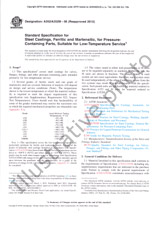We need your consent to use the individual data so that you can see information about your interests, among other things. Click "OK" to give your consent.
ASTM D8004-23
Standard Test Method for Fuel Dilution of In-Service Lubricants Using Surface Acoustic Wave Sensing
Translate name
STANDARD published on 1.5.2023
The information about the standard:
Designation standards: ASTM D8004-23
Publication date standards: 1.5.2023
SKU: NS-1143954
The number of pages: 5
Approximate weight : 15 g (0.03 lbs)
Country: American technical standard
Category: Technical standards ASTM
The category - similar standards:
Annotation of standard text ASTM D8004-23 :
Keywords:
fuel dilution, fuel sniffer, headspace, SAW, surface acoustic wave,, ICS Number Code 75.100 (Lubricants, industrial oils and related products)
Additional information
| Significance and Use | ||||||||||||||
|
5.1?This test method provides a means for a reliable field determination of fuel dilution that is quick and preparation-free. Results are obtained in approximately 1 min. Such a method is used, for example, at remote railroad depots where it is impractical to carry out a standard laboratory method for determination of fuel dilution, such as described in Test Method D7593, but it is a critical need to determine if fuel has contaminated the lubricant. If fuel has contaminated the lubricant, this is significantly detrimental to the machinery and it is typically serviced immediately. Further, the fuel can ignite at the high temperatures encountered in machinery lubricant paths. |
||||||||||||||
| 1. Scope | ||||||||||||||
|
1.1?This test method describes a means for determining the amount of fuel dilution present in an in-service lubricant. This is achieved by drawing into a surface acoustic wave (SAW) sensor vapor from the lubricant. Fuel vapor will be absorbed by the SAW sensors polymer coating. The amount of absorbance is then related to fuel content in the lubricant. 1.2?The range of fuel dilution capable of being measured by the test method is from 0.1 % to 10.0 % by mass fuel dilution. 1.3?This test method is specifically tailored to determining the fuel dilution of in-service lubricants, including newly utilized lubricants. The method is applicable to contamination with diesel, gasoline, and jet fuels. 1.4?The values stated in SI units are to be regarded as standard. No other units of measurement are included in this standard. 1.5?This standard does not purport to address all of the safety concerns, if any, associated with its use. It is the responsibility of the user of this standard to establish appropriate safety, health, and environmental practices and determine the applicability of regulatory limitations prior to use. 1.6?This international standard was developed in accordance with internationally recognized principles on standardization established in the Decision on Principles for the Development of International Standards, Guides and Recommendations issued by the World Trade Organization Technical Barriers to Trade (TBT) Committee. |
||||||||||||||
| 2. Referenced Documents | ||||||||||||||
|
We recommend:
Technical standards updating
Do you want to make sure you use only the valid technical standards?
We can offer you a solution which will provide you a monthly overview concerning the updating of standards which you use.
Would you like to know more? Look at this page.




 Cookies
Cookies
